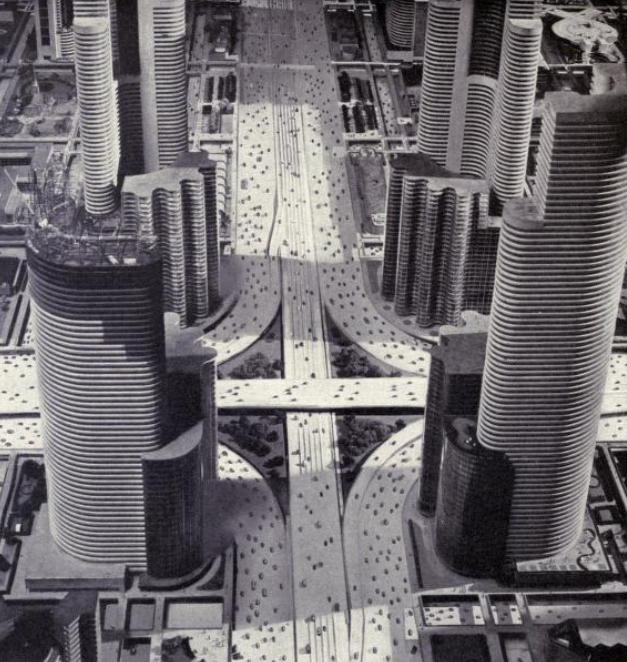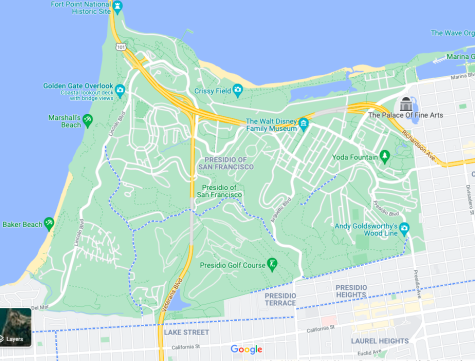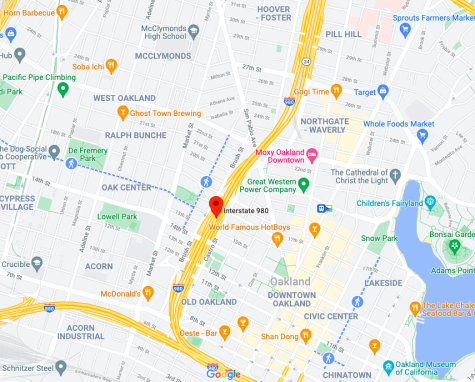
Allen You is a senior at Ladue and the co-editor-in-chief for the Panorama. This is his second year on the staff. His guilty pleasure is listening to too...


December 2, 2021
I hate highways.
“Hereditary” is a movie where things turn into demons and people die out of nowhere and nasty things happen and stuff just floats. It was crazy and scary, but the good kind of crazy and scary. Highly recommend it for horror movie lovers who haven’t seen it.
And after watching the film, I was left with two thoughts. First, I’m not sleeping well tonight. And second, Well, at least I’m not driving on the highway.
Yes, demons, but nothing is scarier than a poorly designed highway exit. The amount of stress that builds from just the sight of the exit from Olive to Lindbergh makes me swerve (it’s been under construction since 1846 it feels like?). Five miles ahead of the exit to Clark Ave. off I-64, I place both hands on the top of the wheel and turn off my music.
Honestly, we could do without highways. If I could go back in time, one of my top priorities is to make sure highways never come into fruition. The American highway system: abominably inefficient and scary to use, yes, but consequential in a trillion other ways. Highways, on the surface, are just long roads, but these concrete behemoths ended up defining American health, commerce, technology, culture, urban design, social issues, housing and my favorite topic, politics. It’s all because highways embody a defining American trait: sprawl.
Here is the beginning of the multi-part series on American sprawl, starting with the Interstate Highway System.
Beginnings
The late 40s. The Allied Powers just won World War II. After two years of total war, the automotive industry was back in bloom. Factories repurposed for making weapons were again repurposed back to producing cars. And from the ashes of the war rose three major automotive phoenixes: Chrysler, Ford and General Motors (GM) – the so-called American “Big Three.”
The Big Three, specifically GM, had been advocating for the futuristic idea of the “freeway” for nearly a decade before World War II ended. Envisioned was a series of concrete roads criss-crossing the US and connecting each major city to the other. These roads would connect rural and suburban areas to inner cities, allowing rural and suburban dwellers to quickly travel between work and home via car.
This idea was interrupted by World War II, but directly following the war, the Big Three started on their work once again. By 1955, an official plan was laid out known as “the yellow book” that detailed how highways would cut through inner cities, state lines and across regions. Finally, the 1956 Federal Aid Highway Act put the nail in the coffin, solidifying the construction of the nationwide Interstate Highway system we know today.
There were previous, smaller policies like the 1944 Federal Aid Highway Act that generated highways and split the cost 50-50 between the constructor and the federal government, but the 1956 Federal Aid Highway Act sparked construction of roads like never before. This legislation subsidized 90 percent of the costs to construct highways, which basically meant roads could be built en masse without regard for cost. Hundreds of billions of dollars would be spent by the federal government to promote this undertaking, which would supposedly be finished in 1992.
The Problem Child
The Interstate Highway system: one of the world’s biggest public works and arguably one of America’s most problematic infrastructures.
Rewind back to the 1955 yellow book. The Interstate plan was done by the Department of Commerce with the aid of automotive executives and highway engineers without the input of city planners or really anyone outside of the DC bubble. Without them, engineers cut and sliced through cities with little regard for the communities that lived there. The primary and only goal was to create access points for those outside the city (suburbanites and rural dwellers) to get inside the city.
If the Berlin Conference taught us anything, it was that letting a handful of people draw lines on developed and settled land is a bad idea. The 1956 legislation gave states free public roads, if and only if they did as the yellow book told. Most areas, looking at potential tax revenue and commerce, agreed. Everything was laid out for them: where, what, how and when to build.
Just a small problem. Highways take up land. And that means land must be cleared to make way for these highways. White politicians, supported by the federal program of “urban renewal” and federal housing bills that subsidized the replacement of houses for high-rises, decided that poorer, predominantly black communities were due for destruction to make way for highways. To make space for affluent, “desirable” suburban travelers, “undesirable” communities were torn down, isolated and brought to their knees, displacing the many who once lived there all in the name of “renewal” and “commerce.” In Detroit, Black Bottom and Paradise Valley were infamously broken to make way for I-375.

But some areas realized the issue with highways. San Francisco ends their highways right before it can cross into the actual city, preserving the streets and neighborhoods that compose San Francisco. This allowed for historic communities to continue on and made for a more walkable, friendly and vibrant city. Imagine what would’ve happened to San Francisco’s famous Chinatown or the historic hills if highways ripped through the city.

Unfortunately, it’s not difficult to imagine that kind of world. Oakland, just across the bay from San Francisco, also opposed the construction of highways. Just not successfully enough to prevent a 2-mile strip of I-980 from being built in 1985 after business interests lobbied the government for the sake of “developing the City Center.” As a result of I-980, West Oakland became isolated from the City Center and Uptown Oakland, preventing them from accessing the benefits of Uptown Oakland’s thriving renaissance. And the supposed economic benefits went up in piles of smoke, literally. The money never came in, but the pollution resulting from constant highway travel caused some of the worst rates of asthma in California in the neighborhoods adjacent to the I-980.
The Interstate Highways ignore urban life in favor of suburban sprawl. The irony of it is that most highway usage is strictly local and suburban drivers use highways to access cities at much lower rates than what was intended. Many cities, with the hope of attracting commerce, instead destroyed everything that makes a city attractive: the historic, multi-ethnic and connected communities that breathe life into the American urban fabric.
Freeway “Culture”
As much as the Interstate system has negatively impacted cities, it has more so defined American suburbia. Because highways, bringing with it the ideal of sprawl, carried the 20th century American Dream as well. The notion that each (white) family could own their own two-story home, swimming pool, garage and picture-perfect lawn pervaded the American consciousness a bit before the highway came along. The highway just made that dream feel more viable, finally connecting the comfy cul-de-sacs to the bustling inner city.
The highway wasn’t just a node though, it was a journey. And along that journey sprung businesses and institutions that serve the freeway traveler and capitalize off the suburbanization of America. Primarily: the shopping mall, the fast-food restaurant and the retail supermarket.
If you’re reading this, you likely live in the St. Louis area. And if you live in St. Louis, you’re aware of two store chains called Schnucks and Dierbergs. So, question: if you removed all the branding from these two stores and walked into one, could you tell them apart?
Supermarkets in America feel copy-pasted over and over precisely because they are just the same exact business model done 100,000 times. Go to Phoenix and you’ll find a store called Fry’s Food and Drugs. I have walked into a Fry’s and it is just Arizonan Dierbergs, even down to the lighting, the grocery bags and the placement of the Hot Pockets. It was like deja vu but ten times worse.
These cookie-cutter stores are dependent and fueled by a trucking industry that can deliver goods in bulk. And the main journey for these trucks is the Interstate. With the help of cheap transportation, retail supermarkets are easily able to compete with smaller grocery stores. Because with cheap transportation and huge amounts of delivery, supermarkets not only offer abundance, but also insane variety. Combine this all with the self-service model that reduces the need for workers, and you have the perfect concoction for a business model that thrives off the free Interstate infrastructure.
The reason why these stores don’t need to look interesting is because they make money regardless. As long as there are the things we want in supply, we will walk in and buy it. Toby Desforges, a consumer business expert, wrote, “Studies time and again bear this out; as grocery shoppers we pay little attention to our environment, only seeking out the products we actually want in a category most of the time.”
And we could take it a step further, talking about how highways enabled brand goods. Brand goods (think your Hot Pockets, your Cheez-its, your Kraft Mac) could produce in extreme amounts in one production site and ship all goods cheaply along highways. Suddenly, goods made across state lines could compete in price with local goods and brand companies took off. The generic item became obsolete as brand companies merged or outcompeted the rest of the market. The supermarket and even the goods inside it were made possible by free public highways, enabling the Schnucks, Dierbergs and Fry’s of America to succeed.
But seemingly on its way out is the shopping mall. The shopping mall was once the mainstay of consumer culture. The luxurious lights of stores lined up one after another used to attract the eyes of the suburban spender. Supermarkets have been around longer than highways, but shopping malls came into fruition right as highways were conceived of. One of the big reasons is space. Highways created little pockets of commerce where exit ramps flowed into. And for towns looking for big developments, malls located at these exit points were again the perfect business model for the job.
Malls were envisioned to be places of high spending, engaging activity and social interaction for suburban populations. Original conceptions for these places sprouted from these ideals – big, open, indoor, air-conditioned spaces that would allow for the unison of people from entirely different cul-de-sacs! And just like the supermarket, it was a success. After the first mall was built in 1956, according to the Association for Consumer Research, “By 1960 there were 4500 malls accounting for 14% of retail sales. By 1975 there were 16,400 shopping centers accounting for 33% of retail sales. In 1987, there were 30,000 malls accounting for over 50% of all retail dollars spent (about 676 billion dollars, 8% of the labor force, and 13% of our gross national product).”
The massive growth of shopping malls no doubt springs from their placement along highways and the suburban growth that would funnel affluent shoppers along these roads and into the parking lots of a Macy’s or JCPenney. In this way, highway-oriented commercial development in the form of supermarkets and shopping malls stimulated economic development in areas that almost shouldn’t exist and only exist due to malls.
Think of Richmond Heights in St. Louis: The Galleria and huge retailers (Target, Michael’s) engulf the intersection of I-170 and I-64. Think of Manchester, where you can find a Best Buy next to a Costco next to a Walmart (not necessarily malls, but you get the point) right off U.S 66 and Highway 141. And even Chesterfield and St. Louis Premium Outlets, which are out in the middle of nowhere but do happen to be constructed right off of ah, South Highway 61.
Highways enable businesses that just don’t work in other nations. You’ll never see a gigantic mall with an even larger parking lot in the middle of France. There’s no Japanese Dierbergs like there is an Arizonan Schnucks. It’s because of the Interstate Highway system that we have these suburban staples. Now, in terms of fast-food chains, let’s table that for the next part since I’m already late on my deadline.
Highways changed everything about America. Because where and how we move is as impactful as any other choice we make. Highways act as connectors but also ironically as isolators, depending on what zip code one happens to live in, whether it be a wealthy suburban one or a poorer, urban one. Modern American sprawl is centered around this fracture of rural, suburban and urban areas and the evolving dynamics between these three American settings. There is no end to the complexity and the politics of this topic, but I hope this was a good primer for it. Next time, we’ll dive into the politics of suburbanization in more depth.
In conclusion, I hate politics.

Allen You is a senior at Ladue and the co-editor-in-chief for the Panorama. This is his second year on the staff. His guilty pleasure is listening to too...